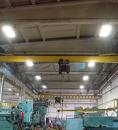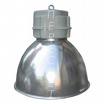Ways to save energy in lighting installations
Electricity consumption for industrial lighting enterprises is constantly growing and is on average 5 - 10% of their total consumption. By individual branches, the consumption of electricity for lighting installation varies significantly: in metallurgical enterprises - about 5%, in machine building -10%, in light industry - and an average of 15%. In some light industry enterprises, the share of electricity consumption of lighting installations exceeds 30%.
Electric lighting — together with other devices for technical equipment of industrial premises, creates comfortable conditions for productive work, the level of illumination significantly affects labor productivity.Therefore, the task of saving electricity through lighting installations should be understood in such a way that with minimal energy consumption through the correct design and operation of lighting installations to ensure optimal lighting of industrial premises and workplaces and high-quality lighting, to create an environment for the most productive work of workers.
For existing lighting installations, the actual lighting depends on the actual lighting, the area of the room; the number of lighting fixtures, the number of lamps in each lighting fixture, the luminous flux of each of these lamps, the coefficient of use of the luminous flux,
The luminous flux of the lamp depends on the type and power of the lamp, the voltage on the lamp and the degree of its wear. The coefficient of use of the luminous flux depends on the following factors: efficiency and shape of the light intensity distribution curve of the lighting fixtures, the height of the lamp suspension, which increases with its decrease, the area of the room S.
Saving energy in the design of lighting installations
 The construction norms give recommendations for the rational colors of the decoration of walls, ceilings, floors, trusses, beams, as well as technological equipment of workshops of industrial enterprises in order to improve the lighting of industrial premises and working conditions.
The construction norms give recommendations for the rational colors of the decoration of walls, ceilings, floors, trusses, beams, as well as technological equipment of workshops of industrial enterprises in order to improve the lighting of industrial premises and working conditions.
When designing natural and artificial lighting in industrial buildings, the increase in illumination of workplaces due to reflected light from the surfaces of the interior, the decoration of which is carried out in accordance with the recommendations of building standards, must be taken into account.
Electricity consumption for electric lighting depends on the number and power of lamps, power losses in the control device (ballast) and in the lighting network, and on — the number of hours of use of electricity lighting installations for a given period (for example, a year).
The duration of the burning of the lamp depends to a large extent on the rational design and the maximum use of natural light.
The rational arrangement of natural lighting in the production area and the creation of sufficient lighting of the work surfaces required by the production process must be provided for in the design of the building. Sometimes this is forgotten when implementing building projects intended for industries with lower requirements for the level of illumination. Insufficient natural light in such buildings below acceptable for this type of production, especially on cloudy winter days, leads to the need to use electric lighting during the day.
The effectiveness and duration of natural light depends on the condition of the glazing and regular cleaning of the glass is necessary to maintain cleanliness. The frequency of cleaning depends on the degree of air pollution in the production area and the outside air.
The rules for the technical operation of electrical installations (PTE) require at least two glass cleanings per year with minimal dust content and at least four with significant emissions of dust, smoke and soot.
Cleaning methods depend on the resistance of the dirt: for easily removable dust and dirt, it is enough to wash the glasses with soapy water and water, followed by wiping.For permanent greasy pollution, oil soot, special compounds must be used for cleaning.
The effectiveness of regular cleaning of glazing is very high: the duration of lamp burning in a two-shift workshop mode is reduced in winter by at least 15%, and in summer by 90%.
Economical consumption of electricity for lighting installations depends to a large extent on the correct choice of light sources and lighting fixtures, as well as on the rational operation of lighting installations.
When choosing lighting fixtures, the height of the premises, their dimensions, environmental conditions, technical data on the lighting of the lighting fixtures, their energy efficiency, required lighting, lighting quality, etc. are taken into account. Reflectors are of great importance to the efficiency of lighting fixtures.
Electric lighting control
 For economical consumption of electricity in electric lighting installations, a rational lighting control system must be provided. A properly built lighting control circuit helps to reduce the duration of lamp burning and for this purpose provides the ability to turn on and off individual lamps, their groups, rooms, buildings, the entire enterprise.
For economical consumption of electricity in electric lighting installations, a rational lighting control system must be provided. A properly built lighting control circuit helps to reduce the duration of lamp burning and for this purpose provides the ability to turn on and off individual lamps, their groups, rooms, buildings, the entire enterprise.
In low and small industrial and auxiliary premises (with a height of up to 4-5 m) it is possible to use switches for one or two lighting fixtures or a small group of lighting fixtures.
For large workshops, it is possible to use remote control of the contactor lighting of the entire workshop and a limited number of places - one or two, which will facilitate it lighting control and will allow more economical use of electricity.
The lighting control panel is located in the staff quarters.
The management of external lighting with its division into parts (lighting of roads and alleys, security lighting, lighting of open workplaces, lighting of large areas and open warehouses) should be as centralized as possible throughout the enterprise. Usually, the lighting management of the entire enterprise is also centralized, that is, the lighting of all buildings and the outdoor lighting. Telephone and remote control cables are used for remote lighting control. The lighting control of the entire enterprise is, as a rule, concentrated on the duty station of the energy equipment of the enterprise.
The centralization of lighting management of the entire enterprise pursues the goal of choosing the most rational time for turning on and off the lighting, combining it with the level of natural lighting, with the beginning, breaks and end of work in the enterprise's workshops.
In practice, various lighting control automation schemes are used. Most often, the control of outdoor lighting is automated. For automatic lighting control, photocells or photoresistors are used, which serve as sensors for automatic controllers. The sensors are adjusted to a certain minimum natural light level to turn off the lighting at dawn and turn it on at dusk.
Saving energy during the operation of lighting installations
 Critical to saving energy there are them in lighting installations proper work and repair. The Office of the Chief Energy Engineer must prepare plans and schedules for inspections, cleaning, replacement of lamps and scheduled maintenance of lighting installations and control of their implementation.
Critical to saving energy there are them in lighting installations proper work and repair. The Office of the Chief Energy Engineer must prepare plans and schedules for inspections, cleaning, replacement of lamps and scheduled maintenance of lighting installations and control of their implementation.
An extensive group of energy saving measures related to the correct operation and repair of lighting installations. The most important of them is the development and implementation of methods and devices for timely cleaning of lamps and replacement of worn lamps, which are extremely important for the rational consumption of electricity for lighting.
Reducing the duration of lamp burning gives direct energy savings, for which measures are aimed at maximum use of natural light, the correct lighting control device, the use of automatic and programmed lighting control.
The rules for the technical operation of electrical installations (PTE) provide that the cleaning of lamps and lamps is carried out in terms determined by the person responsible for the electrical system, depending on local conditions. V Rules for Electrical Installation (PUE) and departmental instructions that I have, instructions on the recommended frequency of lamp cleaning. The loss of luminous flux is increased dramatically by the pollution of the lamps.
In order to ensure economical operation, the used lighting fixtures must allow easy removal of all contaminated parts — protective glasses, reflectors, diffusers, cartridges for their cleaning in stationary workshops.
The processes of replacing movable parts of lighting fixtures with clean ones and cleaning dirty parts should be developed in detail.and workshops with the use of special cleaning preparations and means for mechanization. During operation, there should be an exchange fund of at least 5-10% of movable parts in lighting installations.
It is necessary to eliminate one of the main reasons for the unsatisfactory performance of lighting fixtures - the difficulty of accessing them. This is especially true for workshops over 4m high where these issues are acute. The most convenient for servicing lighting installations are stationary devices, including: technical floors (arranged for various types of communications, ventilation, air conditioning), platforms, special electric bridges.
Maintaining nominal voltage levels in the lighting network
Fluctuations in voltage lead to excessive electricity consumption. The voltage at the lamp terminals should not be higher than 105% and lower than 85% of the nominal voltage. A decrease in voltage by 1% causes a decrease in the luminous flux of lamps: with an incandescent lamp - by 3 - 4%, fluorescent lamps - by 1.5% and DRL lamps - by 2.2%.
One of the main reasons causing significant voltage fluctuations in the lighting network of industrial enterprises is the starting currents of large electric motors mounted on units with heavy flywheels, presses, compressors, hammers, etc. The voltage in the electrical network of industrial plants increases significantly at night when the compensating devices remain switched off at night. Voltage fluctuation is also caused by the change in electricity load during the day.
To eliminate the influence of voltage fluctuations on the efficiency of the lighting installation, separate transformers are used for the lighting load and compensating devices, which are turned on and off strictly according to a daily schedule.
Recently, automatic voltage regulation has been used to stabilize the voltage in lighting installations. For electrical networks for industrial lighting, automatic voltage control using step-up transformers and the inclusion of additional inductance in the network have been developed and are widely used.
